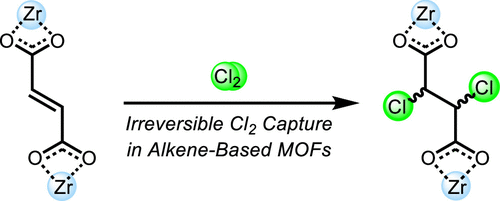Reactive Chlorine Capture by Dichlorination of Alkene Linkers in Metal-Organic Frameworks
-
Authors :
Tyler Azbell, Ruth Mandel, Jung-Hoon Lee, and Phillip Milner
-
Journal :
ACS Applied Materials & Interfaces
-
Vol :
14
-
Page :
53928–53935
-
Year :
2022

Abstract
Chlorine (Cl2) is a toxic and corrosive gas that is both an essential reagent in industry and a potent chemical warfare agent. Materials that can strongly bind Cl2 at low pressures are essential for industrial and civilian personal protective equipment (PPE). Herein, we report the first examples of irreversible Cl2 capture via the dichlorination of alkene linkages in Zr-based metal–organic frameworks. Frameworks constructed from fumarate (Zr-fum) and stilbene (Zr-stilbene) linkers retain long-range order and accessible porosity after alkene dichlorination. In addition, energy-dispersive X-ray spectroscopy reveals an even distribution of Cl throughout both materials after Cl2 capture. Cl2 uptake experiments reveal high irreversible uptake of Cl2 (>10 wt %) at low partial pressures (<100 mbar), particularly in Zr-fum. In contrast, traditional porous carbons mostly display reversible Cl2 capture, representing a continued risk to users after exposure. Overall, our results support that alkene dichlorination represents a new pathway for reactive Cl2 capture, opening new opportunities for binding this gas irreversibly in PPE.
















